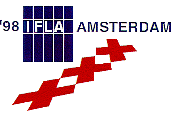
As of 22 April 2009 this website is 'frozen' in time — see the current IFLA websites
This old website and all of its content will stay on as archive – http://archive.ifla.org

As of 22 April 2009 this website is 'frozen' in time — see the current IFLA websites
This old website and all of its content will stay on as archive – http://archive.ifla.org





and
Bohdana Stoklasova
and
Stanislav Psohlavec
In 1996 the UDC Consortium provided the National Library with a license authorizing the Library to "publish (or otherwise make available), distribute and sell the edition(s) of UDC schedules" The UDC Consortium supplied NL the UDC Master Reference File (UDC MRF). Since the UDC MRF is basically a CDS/ISIS-based database, we were at an advantage: in the last 15 years we have had extensive experience with the CDS/ISIS system which was used in the early years of library automation at the National Library. This exposure enabled us to overcome the difficulties contained in this not very user-friendly format.
We formed a team of subject specialists, most of whom were also familiar with the CDS/ISIS system. Almost from the inception, the team debated the format in which the final product should be published, mainly trying to decide between paper or other formats. A printed version was the preferred format since that is what both catalogers and end-users are most familiar with. However, the price of the traditional hardbound edition is an expensive undertaking, considering our financial resources. Although a loose-leaf binder seemed to be a better alternative, especially since we learned already during the translation process that additions and changes will make our work slightly obsolete by the time we will have completed our task, this option too could not be supported by our financial resources. We were forced to look for another, more affordable alternative; besides, if the source material is in electronic format, lending itself to constant updating, why not to disseminate the files in the same fashion?
Although we knew we had to develop a special software allowing frequent updates, we opted for the universally accepted CD-ROM format as the correct medium. The flexibility of the electronic version is of course invaluable especially as it introduces many new ways of using the UDC, thus making this a more powerful and friendly tool than the classical printed version. We are just about to publish the second version of the translated UDC-MRF and we have already started translating the newest UDC MRF edition. We developed software which identifies access points that have been revised or updated so that we don't have to review the entire file. Thanks to the medium's flexibility, we will be able to issue this translation as soon as it is finished and we will always be able to keep the UDC MRF up-to-date. And we are relieved that our initial concerns over how Czech librarians will accept the new version, were ungrounded: its reception was a success.
After a period of negotiations between BSI DISC and Albertina icome Praha (AiP), the Czech company responsible for software development and CD-ROM publishing, AiP won a license to publish a bilingual English-Czech UDC MRF (the second edition already is bilingual).
We have been looking for the best solution for a long time:
We have been hampered in our quest by lack of large databases in our country and by the inability to keep up with international developments. This situation has changed only recently: the number of databases in Czech libraries has grown and the databases themselves are getting bigger. Perhaps most importantly, we started to travel and study abroad.
Searching in our growing databases using free key-words combined with the UDC top level was getting increasingly more onerous. Our subject headings were meant for and derived from printed sources such as catalog cards and the Czech National Bibliography; worse, they lacked strong authority control, the role of which was underestimated in Czech libraries for decades.
Inspired by LC and OCLC, we established NL Subject Headings (NLSH) - the Czech equivalent of the LCSH - and we are going to replace the UDC selected access point (top level) policy with the UDC MRF. Naturally, we also strengthened the role of classification, both in organizing data and searching. We hope that in this way we can contribute to building a bilingual or multilingual database in a hierarchically organized structure.
Despite the attraction of several OCLC projects such as Dewey 2000, DDC 21, Dewey ExTended Concept Trees, we have to continue using UDC classification as it is widely used in our country and it is necessary to continue this tradition, especially so as not to exclude public libraries from the networks.
In view of the new role the traditional library classification scheme (UDC) is playing, we have identified the following necessary changes:
As a result, we expect that in 2001 all bibliographic records representing Czech document production for 1996-2001 will be of high quality, with subject headings created according to the new rules and accompanied by their English equivalents (LCSH). At that time, there should also be a subject authority file linked with the relevant UDC numbers. The Czech version of integrated retrieval information system is intended to correspond to other multilingual projects (i.e. DDC 21).